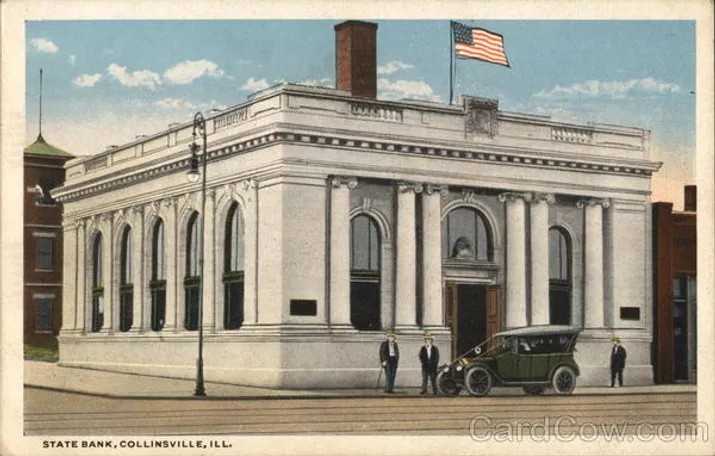State Bank Building
Introduction
Text-to-speech Audio
The State Bank Building is an example of the Neo-Classical Revival style of architecture. Built in 1916 by Robert G. Kirsch, the building’s north and east facades are faced with Amicoloa marble. The building is a two-story building with Amicoloa marble facades on the north and east. The south wall abuts the alleyway, and the east wall abuts the adjacent building. The north façade has three arched bays. Two identical bays flank the central bay that contains the main entrance to the building.
Images
State Bank Collinsville

Backstory and Context
Text-to-speech Audio
The State Bank Building is located at 100 West Main Street in the area of the city known as Collinsville Old Town. The building is a two-story building with Amicoloa marble facades on the north and east. The south wall abuts the alleyway, and the east wall abuts the adjacent building. The north façade has three arched bays. Two identical bays flank the central bay that contains the main entrance to the building. The central fenestration lies atop the pediment to the entrance doors. The massive marble and stone foundation on the north façade rises five feet diminishing the scale of the entrance door, which are set back and bounded by marble columns. In total, six columns couple to encase each bay. The columns are topped with ornate Ionic capitals. Above the capitals is a traditional Greek marble entablature with dentil molding along the cornice. A marble parapet lines the roof with two short balustrades directly above the left and right fenestrations with a simple marble inlay pattern running the width of the parapet.
The east elevation continues with Amicoloa marble in a fashion nearly identical to the theater bays of the front façade. This east elevation has five evenly-spaced bays, though they are larger and minimally differ. The bays are flanked by six pilasters with identical Ionic capitals as the north façade. The parapet extends around the side where, again, two rows of eleven balusters flank the central portion of the marble inlays specifically above the outermost bays.
An addition was added on the south side of the building in 1964. It has modern and unadorned stucco and gravel exterior. The addition is sensitive to the architectural style of the original building but with a modern approach and is considered contributing. On the west façade, three large arched fenestrations sized comparable to the fenestrations on the original building are separated by four pilasters forming three bays. An area with a smaller rectangular fenestration separates the three bays from the original building. The first floor is open with three driving lanes for drive-up bank teller windows.
The first floor of the main building is open with an overhanging balcony. The entrance vestibule is approximately 4’ x 4’ and surrounded by 6-feet high white marble veined with pale green. Beyond the vestibule and upon entering the expansive 2,300 sq ft. room, the same white marble surrounds the entrance columns. There is a two-story vaulted ceiling. Most of the original interior is extant. An elaborate 12-paneled rosette is seen in the middle section of the ceiling. The original rosette had stained glass, which was backlit. The current owner has removed paneling that replaced the original stained glass and has replaced this with backlit Plexiglas. Two chandeliers hang on either side of the rosette, which are new. Six fluted pilasters running along the edge of the room as well as two columns at the entrance and two columns on either side of the vault support the elaborate coffers on the ceiling. Each ceiling coffer has an egg and dart pattern with dentil molding.
The west wall is located on the adjoining building with no windows. The staircase rises on this wall. The original banister is intact leading upstairs with Greek key ironwork and a timber rail. The second-floor balcony rail originally accommodated this same design, and currently, the owner is having the iron and rail custom-made to replace the original. The balcony is approximately 1,100 sq ft. including the second-story vault.
Sources
Researched and Written by Madelyn Knight
Uploaded on behalf Madison County Historical Society by Kiley Fuchs
http://hpa.illinois.gov/PDFs/105874.pdf ; https://www.stltoday.com/suburban-journals/illinois/news/collinsville-history-you-can-bank-on/article_06332eb2-cc0c-5712-9825-d9e649adfadc.html
cardcow.com
